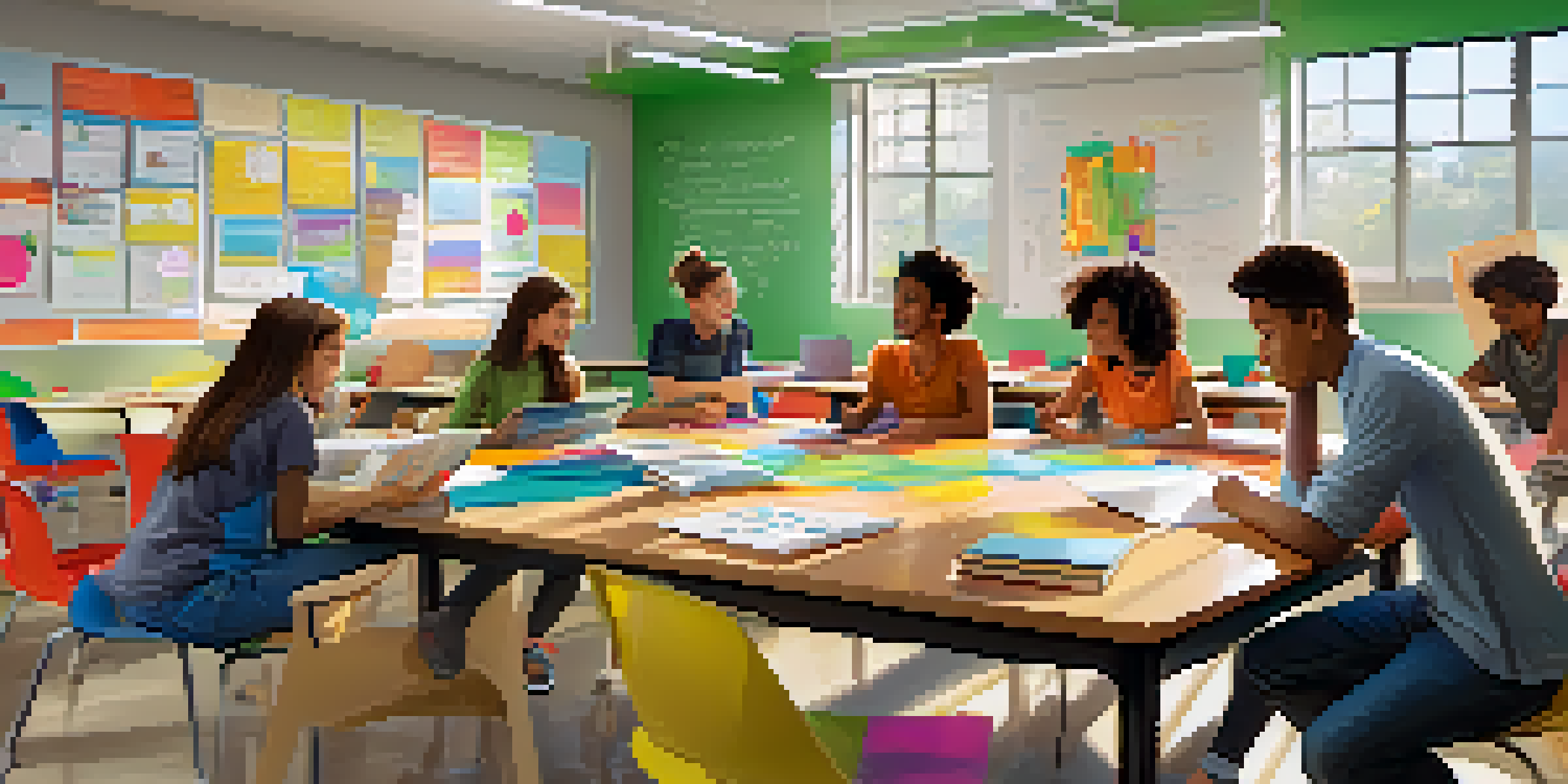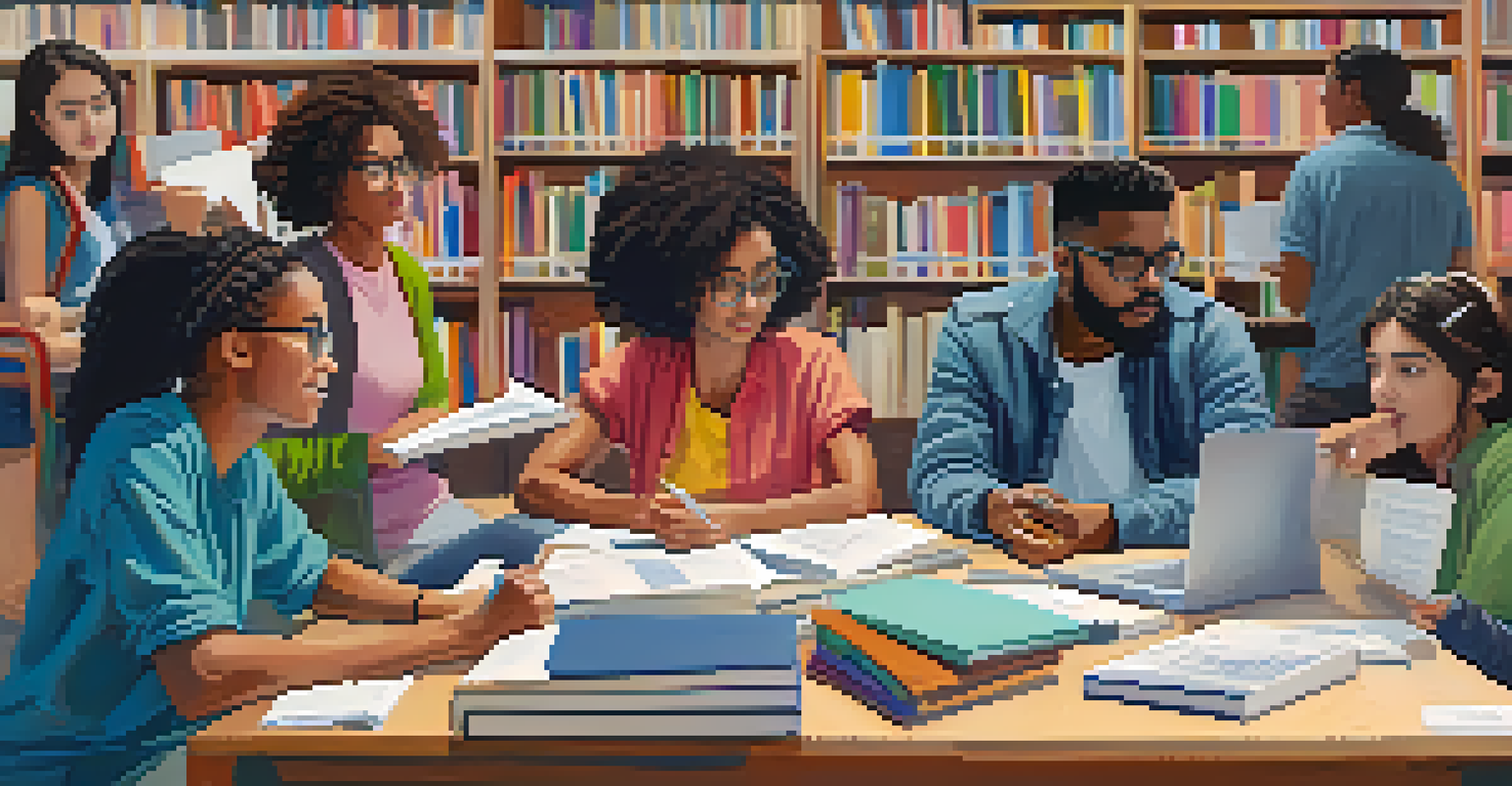Collaborative Learning Environments and Pathway Success

Understanding Collaborative Learning Environments
Collaborative learning environments are spaces where students engage in group work and shared learning experiences. These settings encourage interaction among peers, allowing them to exchange ideas and support one another's understanding. By working together, students can tackle complex problems more effectively than they might on their own.
Collaboration allows teachers to capture each other's fund of knowledge. This is powerful because it allows us to make our practices more culturally relevant.
For instance, think of a jigsaw puzzle. Each student brings a unique piece of knowledge to the table, and when combined, they create a complete picture. This metaphor highlights how collaboration leads to a richer understanding of the subject matter. Ultimately, these environments cultivate a sense of community and belonging among learners.
Moreover, collaborative learning fosters essential skills like communication, teamwork, and critical thinking. In today’s interconnected world, these competencies are invaluable, equipping students for both academic and professional success.
The Role of Technology in Collaborative Learning
Technology plays a crucial role in enhancing collaborative learning environments. Tools such as online discussion forums, video conferencing, and shared document platforms facilitate collaboration, even when students are miles apart. This accessibility allows for a more inclusive approach, where everyone can contribute, regardless of location.

For example, consider a group project conducted over a shared Google Doc. Each member can add their thoughts in real-time, enabling a dynamic exchange of ideas. This not only streamlines the process but also encourages students to engage more deeply with the material as they see their contributions valued.
Collaboration Enhances Learning
Collaborative learning environments allow students to share ideas and tackle complex problems together, leading to richer understanding.
Additionally, technology provides a wealth of resources that students can utilize collaboratively, such as educational videos and interactive simulations. By harnessing these tools, educators can create a more engaging and effective learning experience that prepares students for the digital age.
Benefits of Collaborative Learning for Students
The benefits of collaborative learning extend far beyond just academic performance. Students in these environments often report increased motivation and engagement, as they feel a sense of accountability to their peers. This collective responsibility can inspire individuals to contribute more actively and take pride in their work.
Alone we can do so little; together we can do so much.
Moreover, collaborative learning helps students develop interpersonal skills, such as empathy and conflict resolution. When working in groups, they encounter diverse perspectives and learn to navigate differing opinions. This experience is invaluable, as it mirrors real-world scenarios where teamwork is essential.
Furthermore, the process of teaching others reinforces a student's own understanding. When they explain concepts to their peers, they solidify their knowledge and identify any gaps in their comprehension. This reciprocal learning can lead to deeper learning outcomes for everyone involved.
Creating Effective Collaborative Learning Environments
Designing an effective collaborative learning environment requires thoughtful planning and structure. Educators should consider strategies that promote inclusivity, such as grouping students with varied skill levels. This diversity can enhance the learning experience, as students learn from each other’s strengths and insights.
Additionally, clear guidelines and expectations should be established to ensure that all participants understand their roles. By outlining specific tasks and responsibilities, educators can help prevent misunderstandings and ensure that everyone is engaged. This clarity fosters a more productive group dynamic.
Technology Boosts Collaboration
Tools like online platforms and shared documents facilitate collaboration, making learning accessible and engaging for all students.
Lastly, it’s essential to provide ongoing support and feedback throughout the collaborative process. Regular check-ins can help identify obstacles students may face, allowing educators to intervene and guide them effectively. Encouraging reflection on group experiences can also promote continuous improvement.
Challenges in Collaborative Learning
While collaborative learning offers numerous benefits, it’s not without its challenges. One common issue is unequal participation, where some students dominate discussions while others remain passive. This can lead to frustration and disengagement among quieter group members, undermining the collaborative spirit.
To address this, educators can implement strategies like assigning specific roles within groups. For example, designating a facilitator, note-taker, or timekeeper encourages all members to engage actively. These roles can help ensure that everyone's voice is heard and valued.
Another challenge is managing conflict that may arise during group work. Differing opinions and personalities can sometimes clash, creating tension within the team. Educators must be prepared to guide students in resolving conflicts constructively, teaching them essential skills for collaboration.
Measuring Success in Collaborative Learning
Assessing the success of collaborative learning environments can be complex, as traditional grading methods may not capture the full scope of student engagement. Educators should consider a variety of assessment techniques, such as peer evaluations, self-reflections, and group presentations. These methods can provide valuable insights into both individual contributions and group dynamics.
For instance, a peer evaluation might reveal which students excelled in leadership roles or contributed innovative ideas. Self-reflections can help students articulate their learning experiences and identify areas for growth. Together, these assessments create a comprehensive picture of success within collaborative settings.
Skills Gained Through Teamwork
Students develop essential skills such as communication, empathy, and conflict resolution through collaborative learning experiences.
Additionally, measuring the long-term impact of collaborative learning on student outcomes is essential. Tracking students' progress over time can help educators determine the effectiveness of their approaches and make necessary adjustments. This ongoing evaluation ensures that collaborative learning continues to evolve and meet the needs of all learners.
Future Trends in Collaborative Learning Environments
As education continues to evolve, so too will collaborative learning environments. One trend to watch is the increasing integration of artificial intelligence (AI) in educational settings. AI tools can facilitate personalized learning experiences, allowing students to collaborate more effectively based on their unique strengths and weaknesses.
Moreover, the rise of hybrid learning models—combining in-person and online education—will likely enhance collaboration opportunities. Students will be able to work together seamlessly, regardless of their physical location, making collaboration more accessible than ever before.

Finally, the emphasis on social-emotional learning (SEL) in education is shaping how collaborative environments are designed. By prioritizing students' emotional and social development, educators can create spaces that foster connection and support, ultimately leading to greater success in collaborative learning.